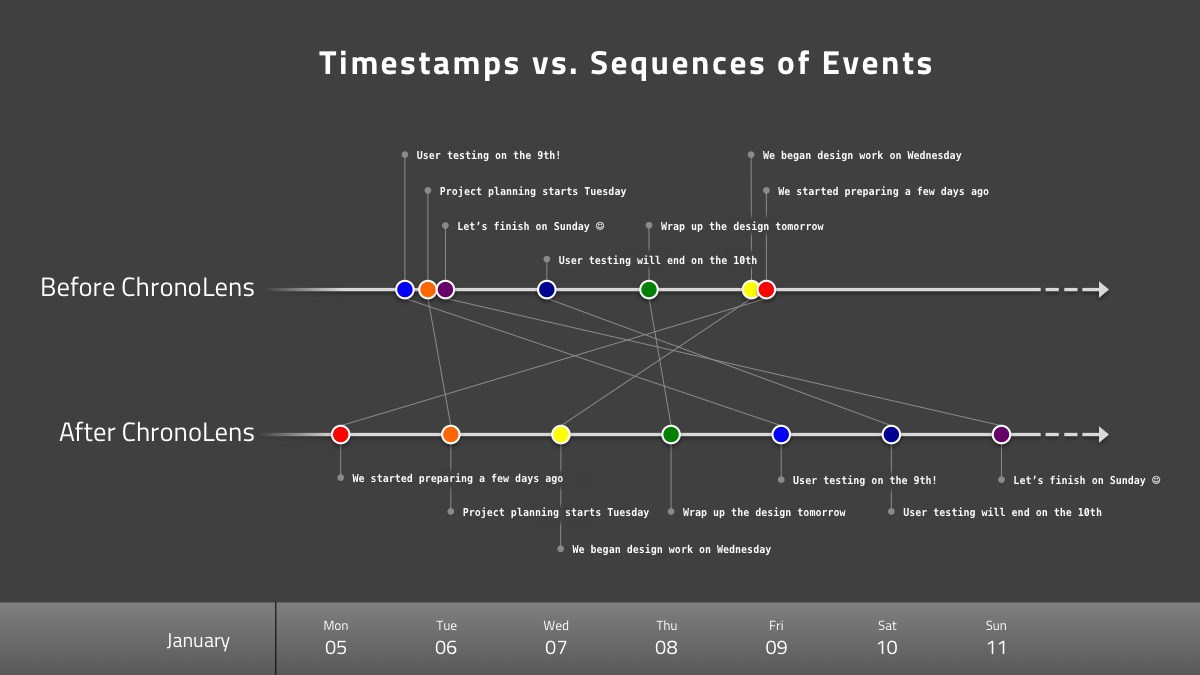Perhaps a more accurate portrayal of events in time wouldn’t be simply ordering messages, but ordering the events that the messages are referring to. For example, if I wrote a message today that said “I’m going on vacation to Tulum next April” (I wish), wouldn’t we want to treat that bit of information as anchored to April rather than today?
Enter ChronoLens. We built ChronoLens to analyze messages to recognize and extract dates and times mentioned within the messages. This means you can get that more accurate picture of the timeline of events quickly, accurately, and automatically! ChronoLens is a web API designed for developers to take better advantage of data and extract more information. It uses advanced text analysis techniques to identify date and time references from plain text. In addition to extracting traditional timestamps and common formats (e.g. “March 21st, 2015”), it also handles fuzzy relative dates such as “today” or “two weeks from now.” Simple references to time confuse many data gathering systems, but they can be the difference between actionable intelligence and old news.
There are plenty of situations where more advanced temporal (read: time) analysis can clarify a series of events, revealing relations, causes, and effects that the human brain has trouble getting its head around otherwise (pun?). Take the classic courtroom drama (or perhaps the recent Serial podcast) — investigators don’t map out the witness testimonies and evidence on a timeline as they learn about them, they arrange them according to how the events actually unfolded chronologically.
Here’s a quick illustration: You’ve got an agile team working on a new product, and their preferred method of brainstorming, planning, and communication is chat messages (Slack maybe?). Now say we want to derive a project timeline in real-time or as a retrospective activity to see how we can improve on the next round. The following diagram shows what the picture looks like using just the message timestamps (without ChronoLens), and what it looks like when you use ChronoLens to derive the actual intelligence — the references to actual dates and times — whether they’re explicit dates, relative references, or “fuzzy” allusions.
You can imagine how the ChronoLens version is actually more true-to-life, and what that could mean for this particular project if some said “actually, I need 5 more days on the user testing…”
Ok, so that’s a simple example — what are other more powerful examples that could impact your bottom line? ChronoLens is applicable across a wide range of business and financial intelligence, litigation support, text analytics, cyber threats, and search and indexing applications. Here are some example use cases:
- Understand competitive product release timelines from news and press releases
- Rapidly organize and comprehend complex sequences of events for litigation support
- Reveal patterns in cyber data by extracting and normalizing dates and times of events across many formats
How will you use ChronoLens?



![[Inside Big Data] Transforming Big Data Into Meaningful Insights](https://signafire.com/wp-content/uploads/2018/07/rawpixel-603009-unsplash-e1560982227714.jpg)
![[Information Week]: Getting Into Analytics, with Signafire’s Aimee Lessard](https://signafire.com/wp-content/uploads/2017/08/AIMEE_LESSARD-SIGNAFIRE-7_25_17-14-BW-MR-WEBSITE.jpg)